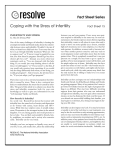Download Create dramatic black and white photographs
Transcript
Creating dramatic black and white photos Black and white photography is how it all began. In Lesson 2, you learned that the first photograph, shot in 1826, was a black and white exposure by Niépce. It wasn't until 1935 that modern color was introduced. The first color film was a three-layer emulsion film representing the full color spectrum of red, green, and blue. Today, your digital camera gives you the option of shooting in full color, black and white, or other tones. Many cameras, printers, and scanners have black and white or sepia tone enhancements so that you can even convert your color images to black and white using on-board settings. With today's technology, virtually any photograph can be converted to black and white. Traditional color photos, slides, and negatives can be scanned to get them into digital form so you can work with them. Once your photos are accessible on your computer, photo editing software makes easy work of converting them to black and white or sepia. Sepia tone is a widely-used monochromatic photo style. Popular for many years, sepia gives photos a reddish-brown, aged look like the photo in Figure 3-1. Sepia tones evoke feelings of nostalgia. Figure 3-1: Using a sepia tone gives new photos an oldfashioned feel. Why select black and white? Now that photographers have the ability to shoot in vivid, lifelike colors, why is black and white photography still so popular? Perhaps it is because black and white photos have a classic, ageless feel. We take pictures to capture and preserve a moment in time. What better way to do this than with a photo that has a timeless feel, in black and white? Figure 3-2: Black and white photos look classic and timeless. Black and white photography is also popular because it allows you to focus on elements of a photo other than color. Without color, you are able to highlight other aspects of the photo, such as composition, texture, and contrast. There are many reasons you might opt to convert a full-color photo to a black and white photo. Professional photographers might convert a color photo to black and white in order to: • • • Eliminate distractions: You might opt to convert a color photo to black and white if there are distracting colors that draw your eye from the main subject of the composition. Eliminating the color removes the distractions, allowing your subject to take center stage. Add drama: Because of its very nature, black and white photography relies heavily on contrast and shadow. Heavily shadowed portraits take on a moody, emotional feel, evocative of old Hollywood portraiture. Focus on the minute details: Far from boring, black and white photos are a mix of black, white, and all the shades of gray in between. The subtle tones allow the eye to focus on the details of the photo instead of color only. Pattern, texture, and shapes become more pronounced when a monochromatic scheme is used. Without the distracting colors, the viewer is able to focus on the unique qualities and individuality of the subject. Notice how the texture of the stones, aging wall, and spiky plant are emphasized in Figure 3-3. Figure 3-3: Black and white photos emphasize fine details like texture and shape. • Save an otherwise dull photo: When a photo is shot on a dreary, overcast day, the colors can appear muted and dull. Such a photo can be dramatically improved by converting it to black and white. Figure 3-4 shows how changing a photo to black and white can take it from ho-hum to breath taking . Figure 3-4: Transform dull photos by changing them to black and white. • Add romance: Because black and white photos are classic and timeless, they are well-suited for romantic images, such as of brides and couples. Many brides today are requesting black and white photos to document their special day. Figure 3-5 shows an example. Figure 3-5: Black and white photos look classic and timeless. • • Add style: Black and white photos are considered elegant. Simply put, they have style. The uncluttered, classic feel is distinctively upscale. When you are going for a look of refined simplicity, black and white is an excellent choice. Change the emotional feel of the photo: Making a photo black and white can sometimes deemphasize an element, changing the way you perceive the emotions between subjects. In Figure 3-6, you can see how changing a color photo to black and white affects how you perceive the relationship in the photo. In the color photo, you sense the woman's appreciation for the flowers. But, in the black and white portrait you detect the man's feelings for the woman. Figure 3-6: The black and white rendition gives the photo a different emotional feel. • Increase versatility: Whether you are shooting landscapes, architecture, portraits, or urban settings, you can achieve stunning results by selecting black and white as your medium. Where color photography is often limited by the amount of available light, black and white photography can be successful in lower lighting. Shooting in low light settings can even • • give your photos a moody feel. Combine light sources: In the first lesson you learned that different light sources emit light at different temperatures, which can cast color on your subject. When you are combining different types of lights such as daylight, fluorescent, and incandescent as additional lighting, you can achieve color balance by converting the photo to black and white Focus on the artistic process: With black and white photography, you can choose to create extreme contrasts or soft, subtle contrasts. This puts the creative choice in your hands, like any satisfying artistic medium. Figure 3-7 shows how a not-so-great photo can become a work of art when converted to black and white. Figure 3-7: Black and white photography is an artistic medium. • Avoid unpleasant clothing color: Sometimes you take a wonderful photo only to realize that your subjects' clothes are clashing colors. When Mary is wearing purple and John is wearing orange, the effect is visually unappealing. Fortunately, the photo can be saved by converting it to black and white. In Figure 3-8, the original combination of black, blue, and yellow lacked visual appeal. Changing the photo to black and white eliminated the clash, creating a striking photo. Figure 3-8: Clashing colors can be corrected by converting photos to black and white. • Even out skin tones: Using a monochromatic color scheme mellows • • skin tones and uneven shading of the skin. The human eye is less capable of detecting these imperfections in black and white. Save a photo with blown-out sectors: When the fill flash causes hot spots or "blows out" a section of your photo, it's sometimes possible to salvage the photo by converting it to a black and white. Turn a backlit photo into a silhouette: Perhaps you have taken a picture where your subject is strongly backlit, causing your subject to be in shadow. Rather than deleting the photo, try creating an artistic silhouette with it instead. By turning the photo to black and white and increasing the contrast, you can sometimes create a pleasing effect. In this section, you have learned how choosing to make certain photos black and white can actually improve the photo. But how can you look at a scene you are photographing and know that it would make a great black and white shot to begin with? In the next section, you will learn to recognize what makes a good black and white photo. Although almost any scene can make a good black and white composition, there are some fundamentals that help you achieve more exciting and interesting black and white photos. As you practice, you can train your eye to look for good black and white photo opportunities. Color versus tone Whereas you normally think in color, black and white photographers think in intensity instead. Look at the scene in terms of a bright to dark scale instead of an array of colors. Remember that as you convert the scene to black and white, neutral tones become gray. Colors of equal tones like red and green will look almost identical in black and white, and some colors that are eye-catching can get washed out. With experience, you will know how the scene will look in black and white without actually shooting the picture. Select a subject that does not rely on color for its beauty. A subject that looks interesting or dramatic will make a good black and white photo. This is the most difficult part of black and white photography, so don't be discouraged if it takes some time to acquire the ability to "see" in black and white. As you view a scene, ask yourself what you would like to emphasize. If your emphasis is dependent on the colors, by all means, shoot the scene in color. Say you are viewing a landscape that includes a red barn against a green hillside. If you want to emphasize the barn in Figure 3-9, use color to do so. If you want to minimize the barn, shoot in black and white. Figure 3-9: Shooting in black and white helped the photographer deemphasize the barn. Contrast and key Just as you train your eye to look for color value, you can also train your eye to look for contrast. In general, black and whites need good contrast between the subject and its surroundings. This helps draw the viewer's eye to the focal point. Without a high level of contrast, the eye is not immediately drawn to one subject. If however, you wish to convey a feeling of serenity and peacefulness, a low contrast setting will help you capture that mood. Figure 3-10 shows the importance of contrast and highlights in black and white photography. Figure 3-10: Strong contrast is the basis of black and white photography. Ideally, a black and white photo should have enough contrast so that the blacks are black, the highlights are white, but there is still detail in the highlights and shadows. The exception to this rule is called high key photography. You may have heard the term high key in fashion and art photography. This term refers to a photo with predominately light tones. A high key photo artistically emphasizes shapes, curves and outlines while fine details are generally obscured by light. Low key, conversely, refers to a photo with predominately dark tones. Lines, shapes, and patterns Objects, shadows, and contrasts create lines and shapes in a photo. Pros know that geometric shapes and repeating patterns can be used to direct the viewer's eye through a photo. Because the eye can easily recognize geometric shapes, they are visually pleasing. Lines, shapes, and patterns are especially important in black and white photography because the lack of color emphasizes them. Lines Using lines in a photo can give a composition perspective and dimension. Just like an artist draws perspective with lines, you can use strong lines in your black and white photography. Seek out lines in your scene, then try photographing them from different angles to keep them from looking flat. Straight lines in a black and white photo can give the photo a modern and architectural style. Figure 3-11 uses the line of the bridge to show the scale and distance. Figure 3-11: Use lines to convey depth. Curves Who says the lines in your composition need to be straight? Curved lines are just as helpful in drawing the eye through the photo as straight ones. Use curves to create dimension and perspective. Curves and crooked lines create visual interest, especially in black and white. In Figure 3-12, the curve of the assembly line creates a very strong composition. Figure 3-12: Curves guide your eye through the photo. Shapes The human brain is "wired" to look for familiar objects. Simple shapes such as triangles and circles create a composition that is very appealing to the human eye. You've learned that positioning a group in a circle or triangle is a fundamental rule of good composition. This applies to black and white photography as well. Because a black and white photo lacks color, it relies even more heavily on these simple shapes to provide interest and appeal. The repetition of the steps in Figure 3-13 gives the photo a very strong level of interest and guides your eye to the focal point. Figure 3-13: Use repeating shapes in your photos. Patterns and repetition Just as your brain seeks out familiar shapes, it also seeks out recognizable patterns. You can use this knowledge to create unity and strong composition in your black and white photography. By filling your photo with repeated patterns, you create good composition that is interesting, with or without color. Figure 3-14: Repeating patterns create a unified photo. Although patterns and repetition are important for the overall composition of your photo, bold stripes and busily patterned clothing can be distracting and unflattering. Loud patterns draw the attention away from the subject's face, particularly in black and white photography. Ask your subjects to wear solid colors instead. Texture Like lines, shapes, and patterns, texture is an important element of black and white photography. Shape filled with texture gives an object its form. A bale of hay has more visual impact than a slab of marble because it has visual texture. When you are taking a black and white photo, seek out texture to create visual interest and contrast. Figure 3-15 is a good example of how texture creates a visually compelling effect. The texture of the brick wall, door, and cart are emphasized by removing color from the photo. Figure 3-15: Texture adds visual interest to your photos. Lighting Without color, light takes on a more important role in a black and white photograph. Train your eye to look for shadows and highlights in your subject. The way a picket fence casts a shadow on the ground, the way trees cast shadows on a building, and the way light falls across a basket of fruit will be emphasized in black and white photography. Remember what you have learned about how the time of day affects natural light in order to achieve the shot you desire. Shooting on an overcast day will result in a low-contrast, calm photo. Shooting in the late afternoon will create dramatic shadows and mood. The easiest way to capture a black and white photo is to set your digital camera to shoot in black and white. Most recent digital cameras give you this option. Check your camera's user manual to select this method. Shooting in black and white allows you to view the photo on your camera's LCD screen so you can see exactly what you're capturing in black and white. Like most things, though, the easiest way isn't always the best way. When you shoot in black and white you are severely restricting your options. If you decide later that you would like to print this photo in color, you can't. Generally, it's better to shoot in color, then change the photo to black and white later. While you're learning to "see" a scene in black and white, it might be helpful to shoot a few exposures in black and white mode so you can see how the colors are displayed on your LCD screen. If you're satisfied with the picture, take the rest of the shots in color. Color modification within the camera Another way to achieve black and white photos is to convert color photos to black and white on your camera. If your camera has this feature, the camera creates a copy of the existing photo so you will have a color copy and a black and white copy on your memory card. Many cameras also include handy, on-board settings for sepia, color tints, and black and white tints for interesting monochromatic photos. Check your owner manual to see what features your camera offers. Although these methods work well, you might find that you want even more control over the resulting photo by using computer software to convert color exposures to black and white. Computer software Most photo editing software and many online photo storage sites can convert photos to black and white. Popular photo-editing applications include Picasa, Jasc Paint Shop Pro, Adobe Photoshop, and Adobe Photoshop Elements. Nearly every photo editing application available has a way to convert color photos into black and white -- and it's usually quite easy! Typically found in the main menu of the graphics editing program, this feature can be called Change to grayscale, Monotone, Remove color information, or Change to black and white. On some programs, this feature can be found under a special effects menu. Using this conversion method is very easy, but you may feel that the results seem flat. This happens because the software drops the color information from the photo, resulting in low contrast between the high and low tones of the photo. To compensate for this effect, adjust the contrast before saving the black and white image. Most photo software programs have ways to adjust the contrast directly, while others include a tool called Levels. The Levels tool, found in Photoshop and other photo software programs, gives you direct and easy control of the contrast using the highlights, mid-tones, and shadows in your photo. Many photographers prefer to convert their digital photos to black and white using color channels, commonly referred to as RGB (red, green, blue) channels. Although it is simple to do, this method gives the photographer more control. To modify a photo using color channels, open the photo in a software program such as Photoshop. Select the tool that allows you to either separate the colors into RGB or adjust the color channels. If you have Adobe Photoshop, follow these steps: 1. Open the photo in the program. 2. On the menu at the top, click Image > Adjust > Channel Mixer. The Channel Mixer tool appears. 3. Click the Monochrome box at the bottom of the Channel Mixer tool and make sure the Red channel slider is at 100%, and you have the Preview box checked so you can see the changes as you make them. Now you have a black and white photo made with the Red channel of RGB. When you have the Channel Mixer up you can adjust the other sliders of Blue and Green to manipulate the results to your liking. Finally, save the photo in its black and white form.




















